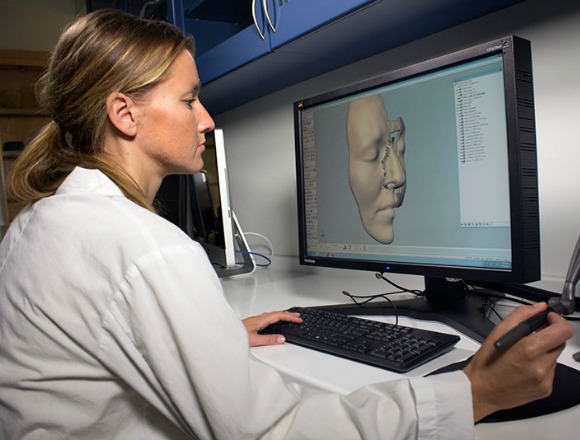
Laila Steen created the first nose simulator to help train medical students to use an endoscope with patients.
(Edmonton) The nose is hardly unexplored territory-no child needs a map to find Captain Booger's buried treasure. But for medical students who need to learn the right way to look up a stranger's schnoz, a map might be just the thing-or even better, a nose simulator.
"They stick a long tool with a video camera called an endoscope up your nose. Typically, medical residents learn their technique on real patients, which can be painful because of the sensitive structures," explains Laila Steen, who graduates Nov. 18 with a master's in rehabilitation science from the University of Alberta's Faculty of Rehabilitation Medicine.
Steen created the first nose simulator to help train medical students to perform the tricky diagnostic procedure, work that was part of her master's work in the the surgical design and simulation specialism program.
The native of Oslo, Norway, constructed the simulator using CT scans of real noses that she manipulated with computer-aided design software, before sending the results to a 3-D printer.
"As well as being cost effective, a simulator is more humane than practising on patients and a great example of how simulations can be used to teach new doctors," Steen explains.
Force sensors were incorporated into the model to provide trainees with immediate feedback through visual or audible signals, similar to a patient, and helps measure performance.
From furniture design to nostrils
Before her foray into nose diagnostics, Steen designed furniture, winning an Interior Design Show Award during her time as an undergrad in the U of A's interior design program. Winning that award made her consider her future as a designer.
"I had the feeling that I could design furniture and be good at it, but at the end of the day was that really what I wanted to do?"
She remembers her sister-in-law describing work she'd done with the Norwegian Peace Core, designing a birth simulator to train people delivering babies in Africa, and felt a strong desire to make a similar impact.
Shortly thereafter, Steen's industrial design class heard a presentation from Heather Logan, a surgical designer and U of A alumna who now works at the Institute for Reconstructive Sciences in Medicine (iRSM).
"One of the things they are known for at iRSM is facial prosthetics, which is normally a very labour-intensive process; hand-sculpting wax models is one example," says Steen.
But using a combination of medical and industrial design tools, the team at iRSM can scan patients and manipulate the digital images with computer-assisted design software to create the models, saving time and effort, and achieving a more accurate representation.
"I was fascinated by the complexity and attracted by the chance to have such a positive impact on people, in this case patients," Steen adds.
Logan was the first student to graduate from the U of A's specialism in surgical design and simulation program. Steen becomes the second, a journey she says was possible from her work under brilliant minds such as Johan Wolfaardt, iRSM's director of clinics and international relations and a professor in the Department of Surgery, and Bill Hodgetts, an audiology professor in the Department of Communication Sciences and Disorders and iRSM's program director of bone conduction amplification.
"It's very exciting to be training and learning with people in this program. You really are at the forefront of the field." - Laila Steen, rehab science grad
"Both are pioneers in their fields. They see the problems on the front line everyday in the clinic and that guides their research. As a designer that's inspiring," Steen says.
In September, 2014, Steen shared her research at the Application of Advanced Digital Techniques in Head and Neck Surgery conference hosted by Peking University in Beijing. This year, Peking University came to Edmonton to learn from Steen and her colleagues at iRSM about the role of digital technology in head and neck reconstruction.
"It's very exciting to be training and learning with people in this program. You really are at the forefront of the field."
One of the reasons Steen chose to study in Alberta was to improve her English, but that now seems laughable considering how her academic career took off. Even before convocation many options presented themselves before she took a job in Belgium as a clinical engineer, working with surgeons around the world in planning and creating custom models and guides for head and neck cancer patients.
"With the work I have done at the U of A and iRSM, learning about medical design and building this nose simulator, I have the potential to work anywhere. It's certainly not the way things would have turned out if I had stayed in Oslo."
___________________________________________________________
The Faculty of Rehabilitation Medicine at the University of Alberta
As the only free-standing faculty of rehabilitation medicine in North America, the Faculty of Rehabilitation Medicine's vision is to be at the forefront of knowledge generation and scholarship in rehabilitation. Through excellent teaching, research and service to the community, the Faculty is committed to enhancing quality of life, promoting participation and autonomy, and improving function for citizens in Alberta and beyond.
A research leader in musculoskeletal health, spinal cord injuries, common spinal disorders (back pain), seniors and dementia and speech-language disorders, the Faculty of Rehabilitation Medicine aims to inspire the realization of the full potential of individuals, families and communities. The three departments, Occupational Therapy (OT), Physical Therapy (PT) and Communication Sciences and Disorders (CSD) offer professional entry programs. The Faculty offers thesis-based MSc and PhD programs in Rehabilitation Science, attracting students from a variety of disciplines including OT, PT, SLP, psychology, physical education, medicine and engineering.
